Messerschmitt Bf 109 E-4
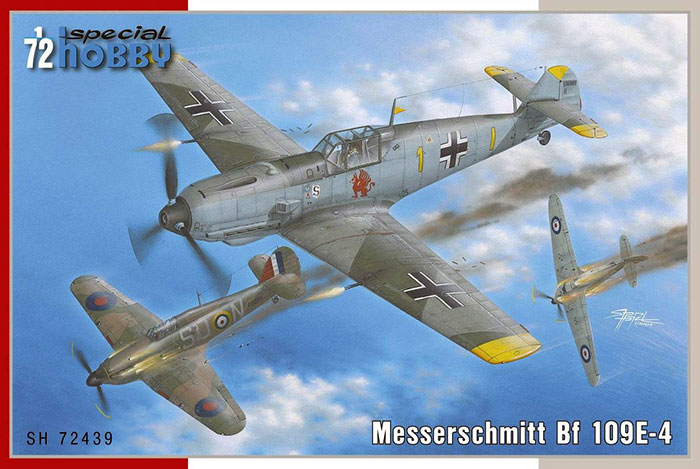
Special Hobby, 1/72 scale
S
u m m a r y |
| Catalogue Number: |
Special Hobby Kit No. SH 72439 - Messerschmitt Bf 109 E-4 |
| Scale: |
1/72 |
| Contents and Media: |
79 parts in grey coloured plastic (plus nine parts not used); four parts in clear (plus three not used); markings for four aircraft plus full stencil data. |
| Price: |
16,20 € plus shipping available online now from Special Hobby
£13.14 EU price (£10.95 Export Price) plus shipping available from Hannants
and hobby retailers worldwide |
| Review Type: |
FirstLook |
| Advantages: |
High level of detail including engine; beautifully crisp and consistent surface textures including rows of rivets; separate control surfaces including flaps and leading edge slats; poseable canopy |
| Disadvantages: |
|
| Conclusion: |
In my opinion, this represents a high water mark for Special Hobby. Surface textures are outstanding, and decisions have been made to provide a fast and easy build with few detail compromises. This is a significant new Emil family and I think we have a new "best Bf 109 E" kit in 1/72 scale. |
Reviewed by
Brett Green

Background
The Messerschmitt Bf 109 A, B, C and D were powered by the Junkers Jumo engine. The Spanish Civil War presented the opportunity to test these revolutionary fighters in action, and they proved their worth in combat with Legion Condor over the skies of Spain.
The Messerschmitt Bf 109 E series was the first of the family to be fitted with the Daimler Benz DB601A engine, resulting in a significant improvement in performance.
Two variants were manufactured in parallel - the lightweight Bf 109 E-1, which retained the wing-mounted 7.9 mm machine guns of the earlier Bf 109 B, C and D; and the Bf 109 E-3, which was fitted with one 20 mm MG FF cannon in each wing. Both variants featured two additional 7.92 mm machine guns in the cowl.

The Messerschmitt Bf 109 E-4 was differentto the E-3 in some small details, most notably by using the modified 20 mm MG-FF/M wing cannon and having improved head armour for the pilot. With the MG FF/M, it was possible to fire a new and improved type of explosive shell that was made using drawn steel (the same way brass cartridges are made) instead of being cast as was the usual practice. This resulted in a shell with a thin but strong wall, which had a larger cavity in which to pack a much larger explosive charge than was otherwise possible. The new shell required modifications to the MG FF's mechanism due to the different recoil characteristics, hence the MG FF/M designation.
The cockpit canopy was also revised to an easier-to-produce, "squared-off" design, which also helped improve the pilot's field of view. This canopy, which was also retrofitted to many E-1s and E-3s, was largely unchanged until the introduction of a welded, heavy-framed canopy on the G series in the autumn of 1942.
The E-4 would be the basis for all further Bf 109 E developments. Some E-4 and later models received a further improved 1,175 PS (1,159 hp, 864 kW) DB601N high-altitude engine; known as the E-4/N; owing to priority being given to equipping Bf 110s with this engine, one fighter gruppe was converted to this version, starting in July 1940.
The E-4 was also available as a fighter-bomber with equipment very similar to the previous E-1/B. It was known as E-4/B (DB 601Aa engine) and E-4/BN (DB 601N engine).
A total of 561 of all E-4 versions were built, including 496 E-4s built as such: 250 E-4, 211 E-4/B, 15 E-4/N and 20 E-4/BN.
Special Hobby has released the debut kit in a new family of 1/72 scale Messerschmitt Bf 109 Es.
This first offering is the widely-used Bf 109 E-4.
Inside the sturdy box, Special Hobby's 1/72 scale Messerschmitt Bf 109 E-4 comprises 79 parts in grey coloured plastic (plus nine parts not used), three parts in clear (plus three not used), markings for four aircraft plus full stencil data.
The first thing that struck me when I opened the box was the surface textures. These are remarkable for this scale.

Crisp and finely recessed panel lines are supplemented with even finer rows of recessed rivets and raised features where appropriate. This subtlety is more like what we would expect to see in 1/48 or even 1/32 scale these days.
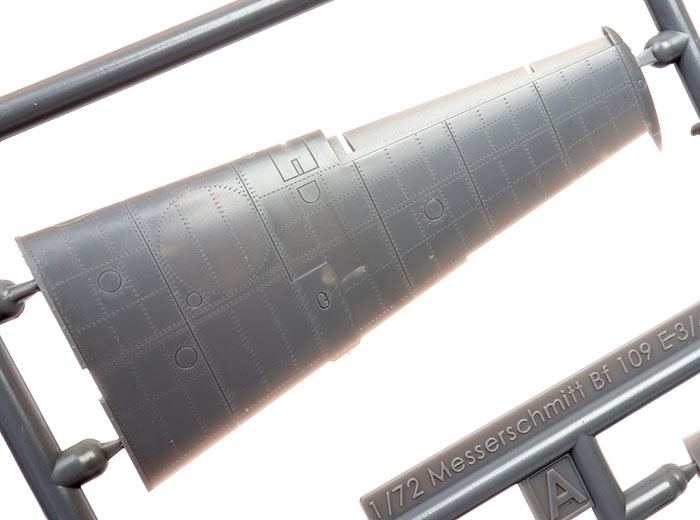
I also liked that the fuselage halves include detail inside the wing roots. I can see a diorama with partially dismantled aircraft in somebody's future!
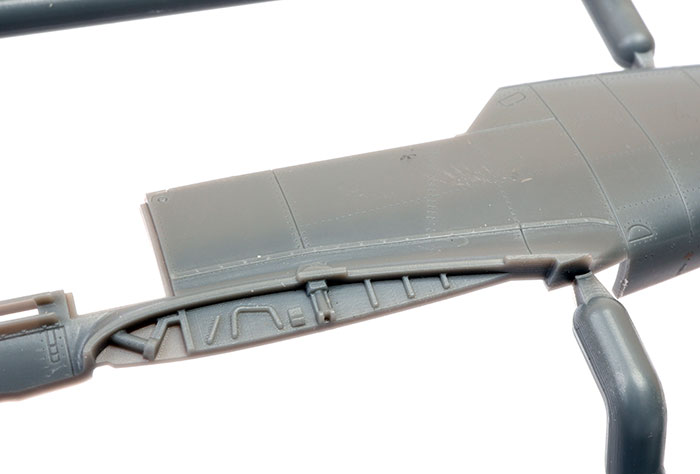
There are locating holes and shallow stubs on the major parts.
Control surfaces feature stretched fabric effect. raised strips and stitching.
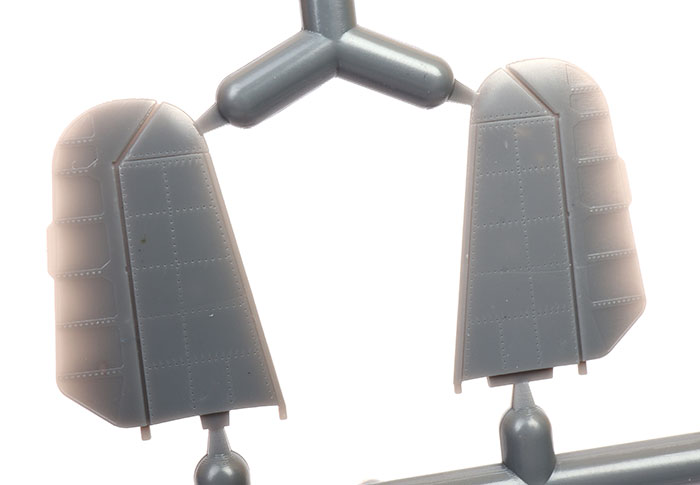
Detail of this all-plastic kit is very good.
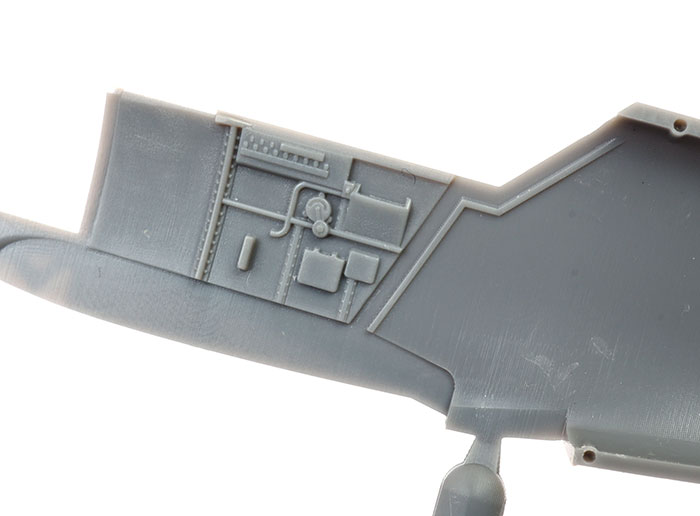
Special Hobby has moulded most of the sidewall detail directly to the inside of the fuselage halves.
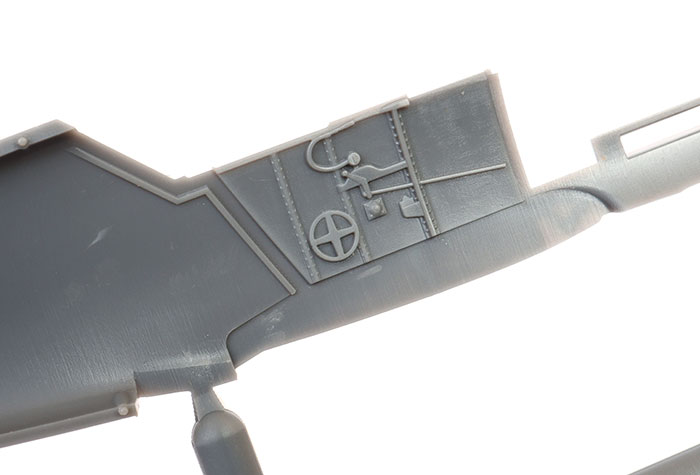
The cockpit floor and the rear bulkhead are nicely detailed and supplemented by rudder pedals (moulded as one parts for the pair), control column, inboard trim wheel, oxygen bottle and gun sight.
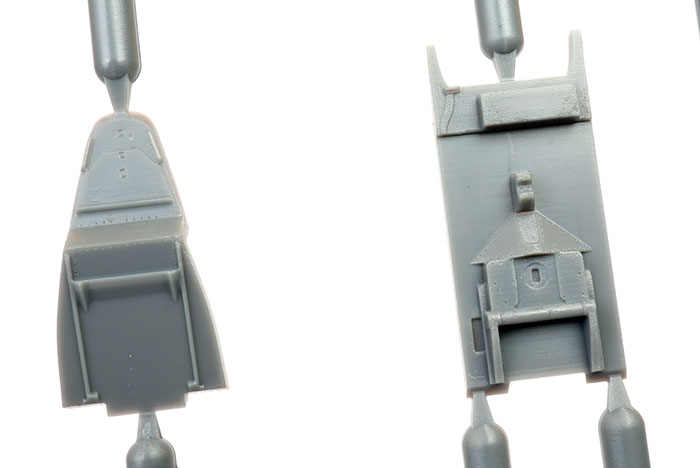
Careful painting will be rewarded in this area.
The instrument panel features raised bezel and switches. Optional decal overlays are supplied for the instrument dials.
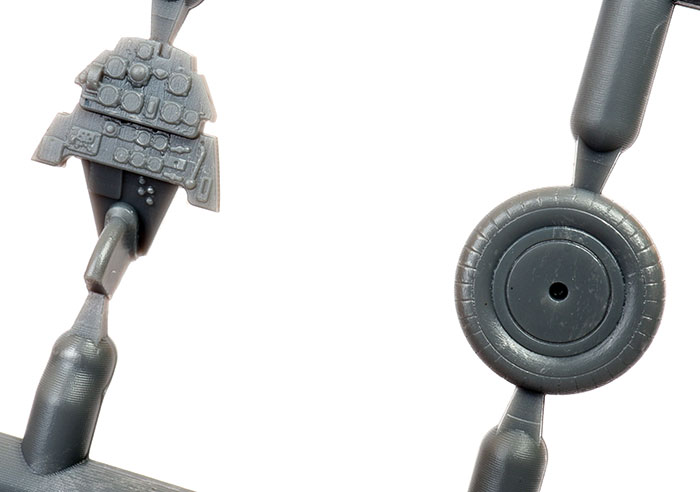
A full engine is supplied. This is nicely detailed. Exhausts are moulded as a single part per side.
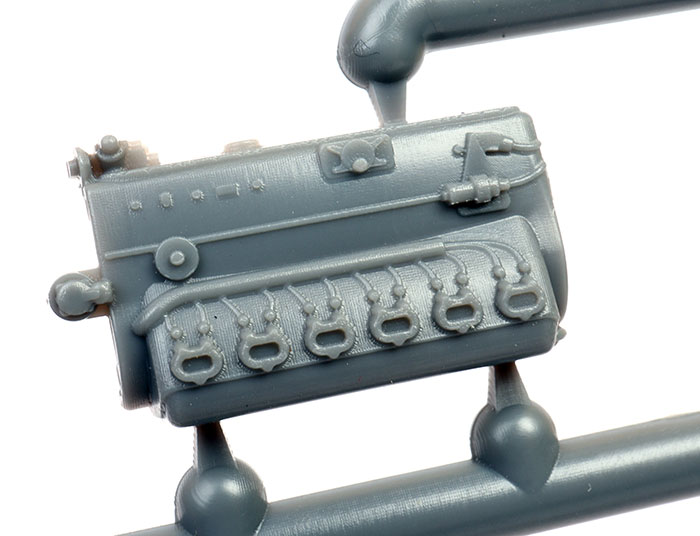
The instructions imply that you can remove the engine cowling to reveal the engine but if I were you I would be test fitting well in advance.
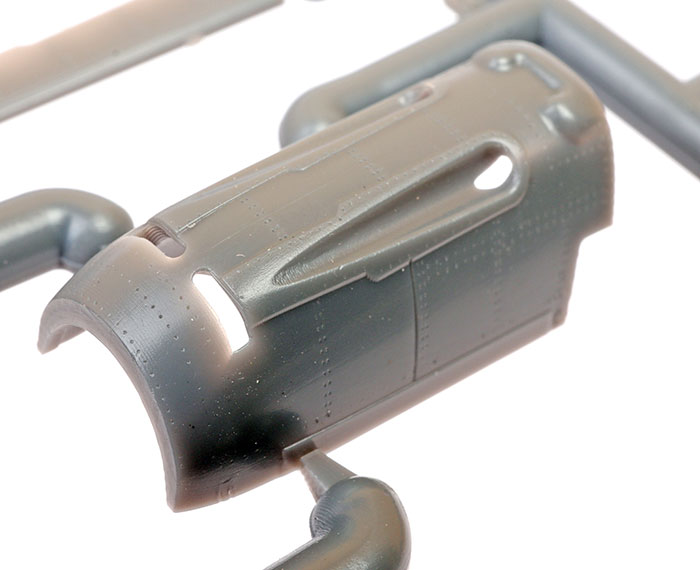
The gun cowl is a separate part too so the cowl guns may be displayed. Alternative gun parts are supplied so you'll need to decide if you want to show the gun cowl on or off.
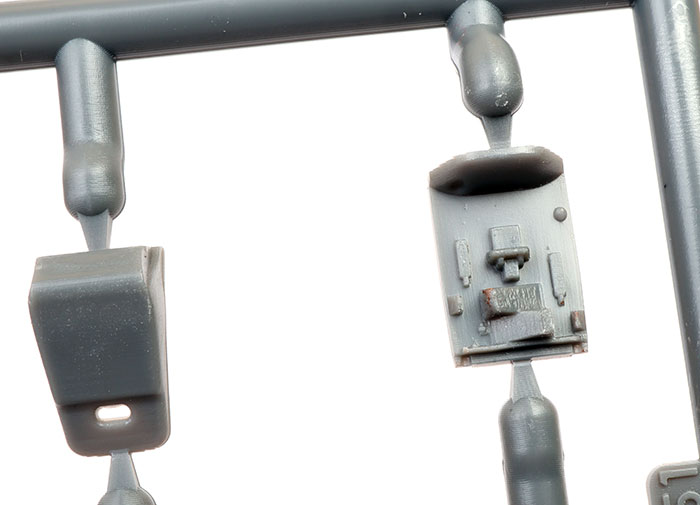
The side fuseage panels are separate parts and may also be left off to display the ammunition compartments.
Most of the control surfaces are separate - flaps, leading edge slats, ailerons and rudder. The elevators are moulded to the horizontal stablisers. Flaps and ailerons are moulded with tabs that will pose them neutral without modification, but it will be very easy to slice off the tabs and reposition if desired.
Radiator flaps are moulded dropped, as one part with the radiator housing.
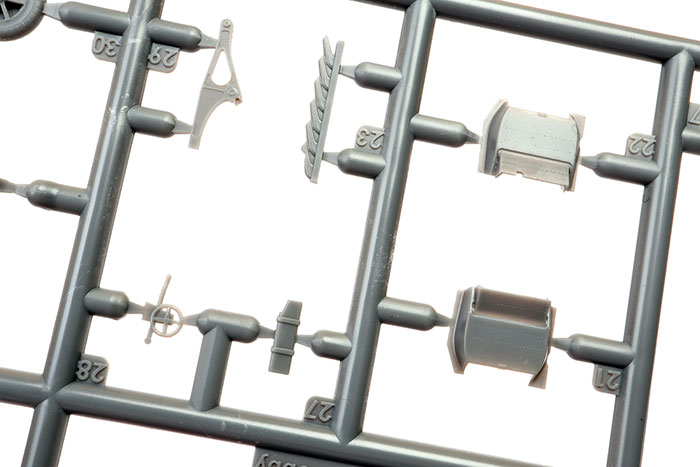
Wheel wells are boxed in thanks to a single part on the inside of the lower wing half that incorporate the gear leg and main wheel bay linings. Wheel well ceiling detail is moulded onto the inside of the upper wing halves.
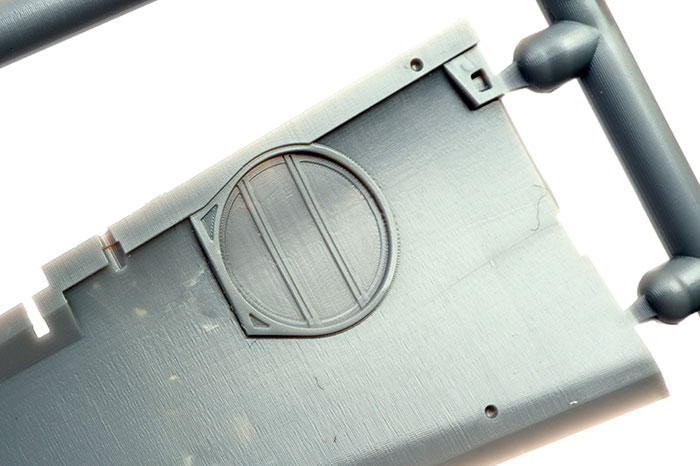
The one-piece spoked main wheels look good. The main undercarriage legs are also moulded as one piece each with the oleo scissors in place.
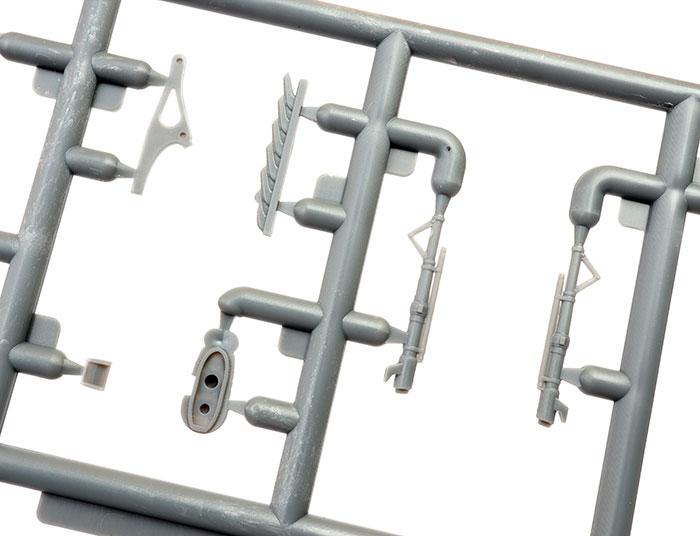
Three styles of propeller spinner are offered.
The later style canopy with the squared off framing is provided as three separate parts. Alternative parts are supplied for both the windscreen and the opening canopy section, but no E-1/3 canopy parts at this stage. A windscreen with external armoured glass is one of the unused options. Check your references carfully. The final clear part is the gun sight.
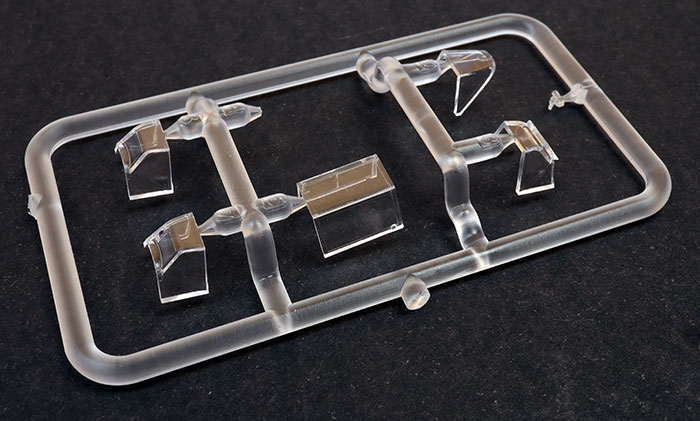
All the transparent parts are thin and free from distortion.
Leading Edge Slats
I won't attempt a full accuracy appraisal here, but I have already seen the claim that Special Hobby's leading edge slats are too deep. This suggestion has its roots in the same comment made about the Eduard 1/32 and 1/48 scale kits.
It was not something that leapt out at me when I was looking at the parts on the sprue, but I decided to look into it anyway.
Back in 2012 when the Eduard 1/48 scale kit was released, I thought I would test this hypothesis. Here's what I can up with back then:
"One of the popular ongoing discussion points about Eduard's 1/32 scale Emil kits is the depth of the leading edge slats. On that kit, the slats are too deep. The depth at the widest point is 10 mm. If we scale this down to 1/48 scale, the depth would be 6.66 mm.
The Airfix 1/48 scale Messerschmitt Bf 109 E slats are often referred to as looking correct. I measured the Airfix slats at their widest point and they are 5.5 mm deep.
The new Eduard 1/48 scale slats are approximately 6.0 mm deep. This is 10% narrower than the scaled-down 1/32 scale slats, and only 0.5 mm different to the Airfix slats. I cannot confirm the exact depth of the real slats as I do not have any plans that I would trust to that level of detail; and I foolishly failed to bring a tape measure when I came face to face with an Emil in 2005!
However, I took a photograph of the Eduard and Airfix slats together to demonstrate the visual impact of this discrepancy.
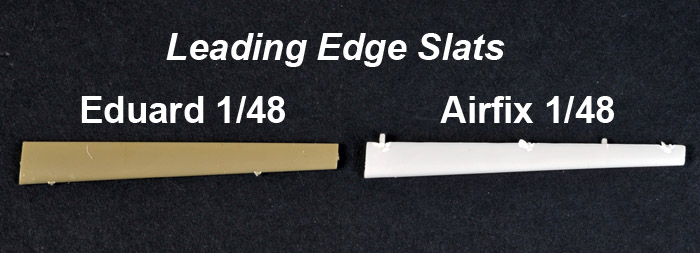
The photograph is taken from directly above with both slats lying side by side on the table at the same time."
Scaling that down from the supposedly accurate Airfix 1/48 scale kit, this would be a depth of 3.66mm in 1/72 scale.
Fast forward to 2020 and I have just measured the new Special Hobby Bf 109 E slats at their widest point.
They are 4mm, give a micron or two.
This means that the difference between the 1/72 scale depth of the Airfix slats is around 0.33mm compared to the new Special Hobby slats. And that is assuming that the depth of the Airfix slats is correct.
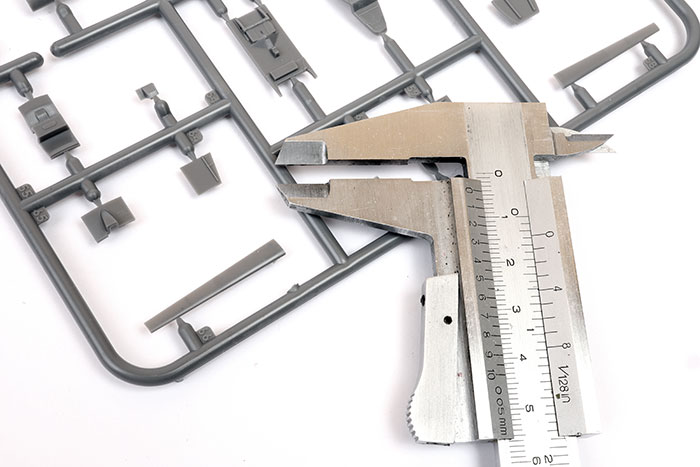
Personally, I'm not worrying about a possible discrepancy of one third of one millimetre.
However, if you find the depth visually unacceptable, it will be quite easy to shim the rear of the upper flap bay with thin plasticard, then sand the depth of the slats back ever so slightly.
It's your hobby - the choice is yours!
Markings
Four marking options are included:
-
Bf 109 E-4, Yellow 1 + |. This aircraft is finished in a scheme of RLM 02 Grey and RLM 71 in a splinter pattern on the upper surfaces with high demarcation on the fuselage sides and no mottling. Lower surfaces are RLM 65 Light Blue. Tail surfaces and wings are tipped with yellow.
-
Bf 109 E-4, W.Nr. 4148, Yellow 2. This is Helmut Wick's well-known Emil with intricate spotty camouflage. I'd never say "impossible" but this would be a very tricky scheme to paint in 1/72 scale. Fortunately, Special Hobby has released a separately available decal sheet with the fuselage mottling. Nice idea!
-
Bf 109 E-4, Double Chevron and Bar|. Special Hobby suggests this one is in the mid-war colours of RLM 74/75/76 greys, but I think it is equally likely that it is finished in the early scheme of RLM 02/71/65. Yellow 04 cowling and Green 25 tip on the spinner.
-
Bf 109 E-4, Yellow 8 in RLM 02 Grey and RLM 71 in a splinter pattern on the upper surfaces with mottling on the fuselage sides. Lower surfaces are RLM 65 Light Blue
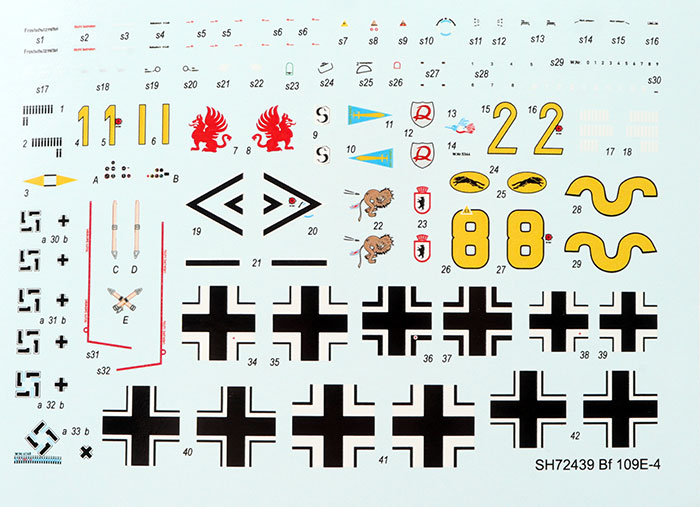
Stencil data, harness straps and instrument dials are also included.
Register is perfect. There is no indication of who printed the decals.
In my opinion, this represents a high water mark for Special Hobby.
Surface textures are outstanding, and decisions have been made to provide a fast and easy build with few detail compromises.
This is a significant new Emil family and I think we have a new "best Bf 109 E" kit in 1/72 scale.
Thanks to Special Hobby for the sample.
Review Text & Images Copyright © 2020 by Brett Green
Page Created 16 December, 2020
Last updated
17 December, 2020
Back to HyperScale Main Page
Back to Reviews Page |
